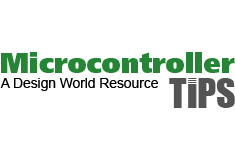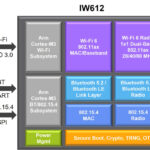Matter enables designers to develop smart home accessories that work across all major wireless platforms. Mesh functions are possible because Matter operates as an application layer on top of technologies like Ethernet, Wi-Fi, Bluetooth, and Thread. Matter aims to simplify the setup and use of compatible smart home devices and bring some level of interoperability on Google Home, Apple HomeKit, Amazon Alexa, and other platforms.
Matter started out being developed by the ZigBee Alliance as the Connected Home over IP (CHIP) project. It continues to be developed under its new name as the Connectivity Standards Alliance, the new name for the ZigBee Alliance.
Matter 1.0 runs on Ethernet, Wi-Fi, and Thread network layers and uses Bluetooth Low Energy for commissioning. It provides designers with a unified open-source application layer to speed the development of smart IoT devices. It’s designed to improve compatibility and ensure interoperability, making it simpler to design devices with smart home and voice services like Apple’s Siri, Google’s Assistant, Amazon’s Alexa, and others. Consumers can add new devices and brands to a Matter smart home network with confidence that they will work together (Figure 1).
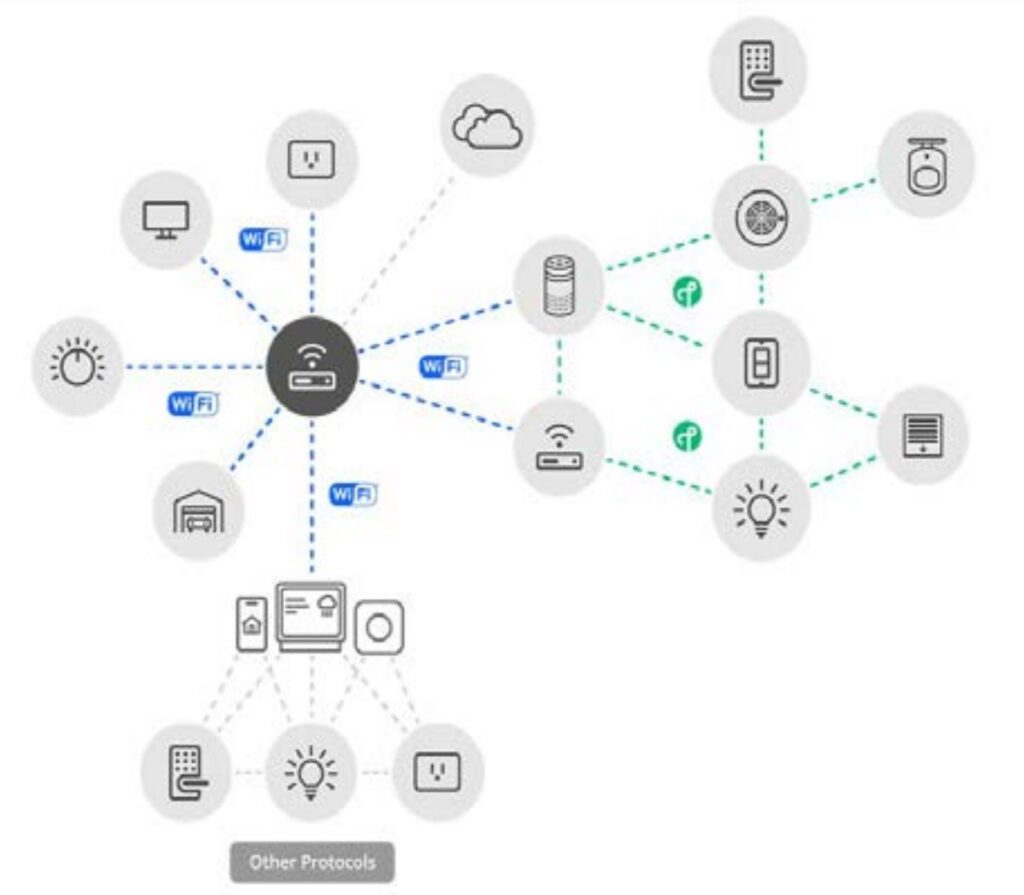
The Connectivity Standards Alliance has launched the Matter 1.0 specification as part of a complete development ecosystem, including test cases, detailed testing tools, and a global certification program that includes eight authorized test labs that can test Matter’s underlying network technologies as well as the Matter protocol functions. The Thread Group and Wi-Fi Alliance worked with the Connectivity Standards Alliance to enable the development of the Matter product development and deployment ecosystem. From the start, Matter strongly focuses on security processes and policies, including distributed ledgers and Public Key Infrastructure, to validate devices in real time as they are added to the network.
Matter is also designed to enable the optimal wireless protocol for each use case. As noted, Matter initially includes support for Wi-Fi and Thread network layers for core and operational communications and Bluetooth Low Energy (LE) to simplify device commissioning and setup.
Various wireless protocols offer a range of power and bandwidth combinations. Thread, Zigbee, and Z-Wave offer low power operation, Z-Wave and Wi-SUN are suited for longer-range transmissions, and Wi-Fi supports high bandwidths. With Matter, these technologies can share a common application layer enabling seamless communication with the cloud. The Matter specification includes bridging to enable protocols like Zigbee and Z-Wave that are not directly supported to communicate over a Matter network.
Matter simplifies the development process by reducing functionality to a single ecosystem while simultaneously supporting communication and control among several services like Amazon Alexa, Apple Siri, or Google Assistant simultaneously. Matter provides designers with a common layer for events like commissioning, provisioning, and device and profile discovery over an IP link. All that’s needed is certification of the Matter functionality to ensure interoperability and simplicity of use.
While the Connectivity Standards Alliance is responsible for both Matter and Zigbee, they are not substitutes, and both will continue to be developed in parallel. There is some relationship since Matter application interactions and objects were inspired by the Zigbee Cluster Library. But Matter is designed to operate on top of IP networking protocols, while Zigbee includes an IP networking protocol. In addition, Zigbee’s default commissioning process uses its IEEE 802.15.4 radio, while provisioning in Matter can take place over Bluetooth LE or Wi-Fi quick response (QR) codes.
Matter provides a universal open-source abstracted application layer between the device application and ecosystems at the top of the software stack and the IPV6-based communication protocols in the transport layer at the bottom (Figure 2). For full functionality, three types of radios (Wi-Fi, Thread, and Bluetooth LE) and a Matter API are needed to make IoT products from any manufacturer interoperable with other products and ecosystems.
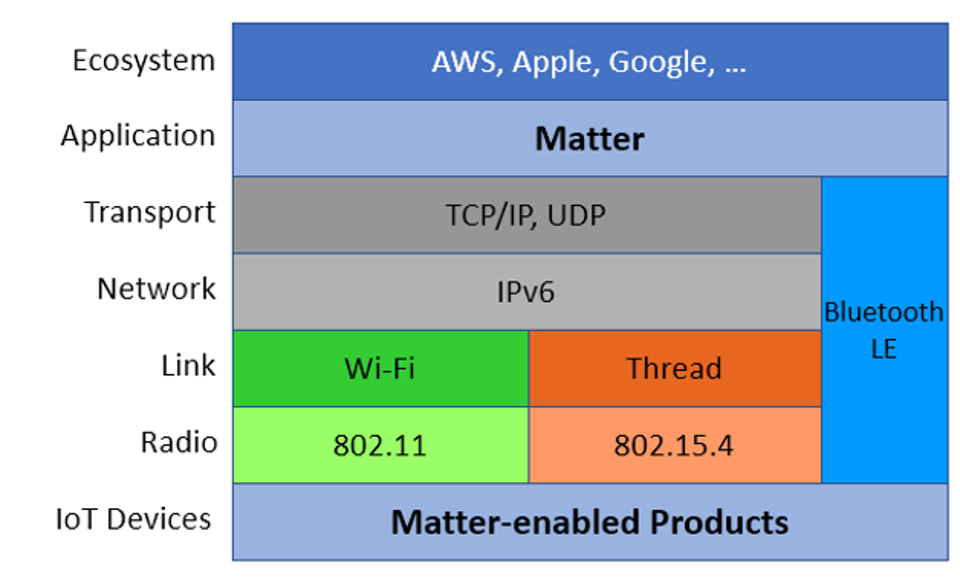
Matter use cases
Matter is initially targeted at smart home networks and has been designed to support low bandwidth, low-energy Zigbee devices, and higher bandwidth networks like Wi-Fi. Matter aims to make those networks interoperable and reliable with a high level of security baked in to make it easier for users to expand smart home networks without having to consider complex factors. In the future, Matter is expected to be used in a growing range of use cases:
Commercial Buildings – Smart commercial building technologies use wireless IoT networks to optimize heating, ventilation and air conditioning, lighting, and overall energy consumption. In addition, access is controlled, and security is maintained wirelessly based on whether the individual is the building owner or landlord versus tenants and guests. Matter will enable the integration of diverse smart building systems into a single network.
Connected Healthcare – Personal connected devices operating in Matter enable networks can link individuals at home to doctors’ offices, clinics, and hospitals through robust, secure, and private communications that can adhere to the Health Insurance Portability and Accountability Act (HIPAA) and other international laws related to healthcare data management. The simplification enabled by Matter can help improve the quality of care as well as the quality of life for individuals.
Industry 4.0 – Today, advanced factory automation systems and the industrial IoT (IIoT) use a diversity of networking protocols that can lead to the creation of so-called “automation islands”. Matter can link those islands, improving operational efficiencies, lowering costs, and enabling more rapid deployment of emerging automation technologies. Process control, quality, supply chain management, and other business functions can be improved by leveraging the strengths of Matter-based networking.
Retail & Consumer Experiences – In retail, there’s a growing need to link in-store and online experiences for customers and management. Improvements in inventory management, knowing what inventory is available at each location in real-time, improved promotional activities, and even improved checkout experiences can all be supported by the diverse networks that Matter makes possible. Security of personal and business information is an important consideration and is supported by Matter.
Connected & Autonomous Vehicles – As the automobile industry moves toward autonomous vehicles, connectivity is increasingly important. Wireless connectivity needs in cars and trucks include interactions between vehicles, drivers, and passengers, connecting with smart transport systems, fleet management, vehicle maintenance, and more.
Sustainability & Smart Energy – Sustainability is increasingly important and is supported by smart energy and smart cities. Monitoring, measuring, and managing energy generation and consumption is one key to sustainability. The same goes for effective water and wastewater management. Matter combined with wireless protocols like Zigbee Smart Energy can significantly lower the costs when deploying the comprehensive and complex networks needed by these applications. Sustainability solutions need interoperable products, and they need to be adaptable and expandable as needs change and technology advances.
Typical Matter use scenario
Using Matter is not an “either-or” decision. Users can simultaneously install a new Matter device integrated with multiple smart home ecosystems like Amazon Alexa, Apple HomeKit, and Google Home. Device authentication is part of the Bluetooth commissioning process, helping to ensure network security. Users can add devices to Matter networks using a simple step-by-step process. The following example uses a connected coffee maker, but the device could be an Industry 4.0 node or any other of the use cases outlined above (Figure 3):
- A commissioning device like a smartphone or table is used to scan the QR code attached to the back of the coffee maker. The QR code is unique to that coffee maker, identifies the device, and enables secure communication.
- Pressing a pairing button on the coffee maker starts the installation process. The commissioning device uses the cryptographic information included in the QR code link, establishes a secured connection to the coffeemaker, verifies that the coffee maker is Matter certified, and identifies it as a coffee maker.
- The commissioning device sends the information needed for the coffee maker to join the network, like Wi-Fi passwords and other credentials required to communicate securely with other devices in the network.
- Upon completion of the installation, the coffee maker can communicate with other devices on the network. For example, a smart speaker/microphone can be used to begin a specific brewing process, set a start time for brewing, and it can alert users when brewing is completed.
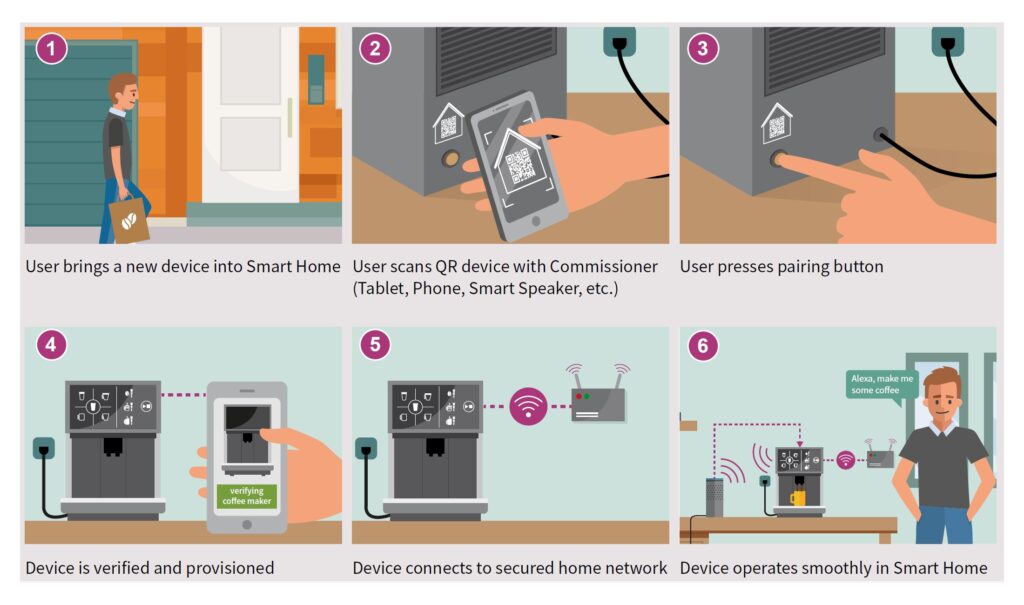
Summary
Security and simplicity are two of the hallmarks of Matter installations. Matter includes comprehensive security, including distributed ledgers and Public Key Infrastructure to validate devices as they are added to the network. And adding devices to a Matter network can be a simple process using QR codes and automated commissioning to quickly ensure the reliable operation of diverse platforms like Google Home, Apple HomeKit, and Amazon Alexa. Matter has been designed for use in many use cases, including home, industrial, healthcare, automotive and smart city networks.
References
A FAQ about the Matter connectivity standard, Texas Instruments
Matter, Silicon Labs
Matter And Thread Win The IoT Connectivity Wars, Moor Insights, and Strategy
The Matter Standard: Implementing Improved Security and Connectivity for the Smart Home, Infineon
